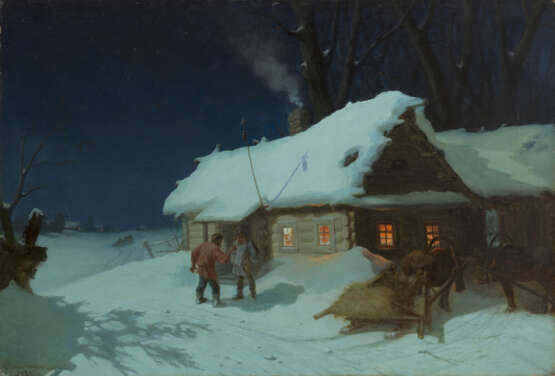SOLOMATKIN, LEONID (1837-1883) Night Scene near a Tavern , signed and dated 1872.
29.11.2017 11:30UTC +00:00
Classic
Prix de départ
130000GBP £ 130 000
| Auctioneer | MacDougall Arts Ltd. |
|---|---|
| Lieu de l'événement | Royaume-Uni, London |
| Commission | 27 % |
Archive
La vente aux enchères est terminée. Vous ne pouvez plus enchérir.

ID 12089
Lot 25 | SOLOMATKIN, LEONID (1837-1883) Night Scene near a Tavern , signed and dated 1872.
Valeur estimée
£ 130 000
Provenance: Important private collection, Europe.
Authenticity of the work has been confirmed by the expert E. Nesterova.
Authenticity has also been confirmed by the expert V. Petrov.
Literature: E. Nesterova, Leonid Ivanovich Solomatkin, St Petersburg, Zolotoi Vek, 2006, No. 66, illustrated.
The work presented for auction, Night Scene near a Tavern, belongs to the latter period of Leonid Solomatkin’s oeuvre, when “the Gogol in painting”, as his fellow artists called him, produced his most original pictures. Of the 200 pictures that he painted barely a quarter have survived: many are now lost irretrievably. That is why the appearance at an auction of such a rare canvas, one of the best in the celebrated artist’s legacy, is a major event.
Leonid Ivanovich Solomatkin (1837–1883) was a gifted Russian genre painter who displayed a striking individuality and artistic flair. The painter has been called “the artist of the urban poor” because of his penchant for depicting “the city’s low orders” who “liked hang out by a tavern”. The artist himself was one of them, so that he depicted his characters with a good deal of empathy and humour, without the finger-pointing tendentiousness shown by many painters among his contemporaries. The grotesque expressiveness of the images together with a concise painting style and an emotional handling of colour, as well as a rare sense of self-deprecating humour, make the master’s works quite distinctive.
The picture Night Scene near a Tavern is typical of Solomatkin in terms of its subject matter and artistic technique. What is depicted is probably an inn on the outskirts of a village. The horse-drawn sleigh that is standing by the gate indicates that visitors are likely to be able to stay at the house overnight. The log building stands on a patch of higher ground. It is brightly lit and can be seen from a distance. The establishment’s curious advertising sign – a bottle tied to a stick high above the roof – leaves no doubt that weary travellers will be able to rest, warm themselves and relax there. The artist has managed to convey a sense of hard frost and rural night-time tranquillity, whereby local life comes to an end once darkness has fallen, and any noises that unexpectedly disturb the calm resound far away in the frosty air. Despite all its genre specificity, with a precise depiction of the poses of the tipsy patrons who are clearly arguing about something, this scene contains a great deal of curious poetry and imparts a predominantly lyrical feeling. The subject of Solomatkin’s work calls to mind one of the best pictures by Vasily Perov, The Last Tavern by the Town Gate (1868), yet the colour scheme and the lighting – the dark sky, the white snow, gleaming coldly in the moonlight, the bright, blazing light in the establishment’s windows and the contrasting dark shadows – remind one of the future experiments of Arkhip Kuindzhi.
Solomatkin’s pictures stand out among the work of his contemporaries both by virtue of his expressive character types and his interesting treatment of colour; but they are primarily memorable through their entirely distinct vision of reality – a vision that is grotesque, tragic and romantic at the same time.
| Adresse de l'enchère |
MacDougall Arts Ltd. 33 St James’s Square SW1Y 4JS London Royaume-Uni | ||||||||||||||
|---|---|---|---|---|---|---|---|---|---|---|---|---|---|---|---|
| Aperçu |
| ||||||||||||||
| Téléphone | +44 20 7389 8160 | ||||||||||||||
| Téléphone | +7 495 799 4683 | ||||||||||||||
| Fax | +44 (0) 20 7389 8170 | ||||||||||||||
| Commission | 27 % | ||||||||||||||
| Conditions d'utilisation | Conditions d'utilisation | ||||||||||||||
| Heures d'ouverture | Heures d'ouverture
|



